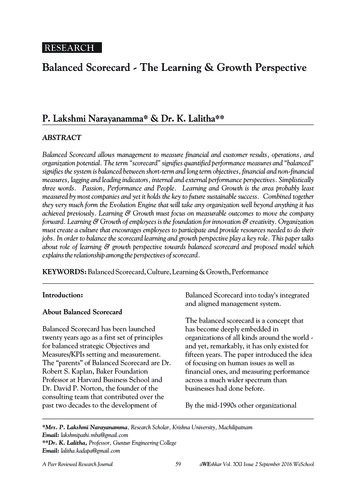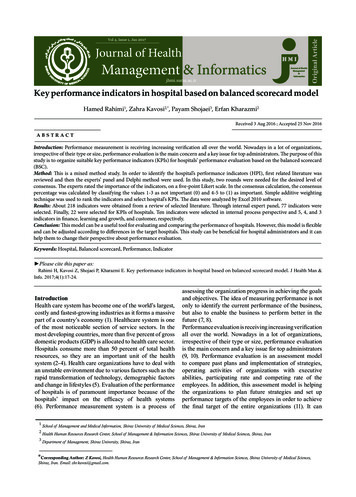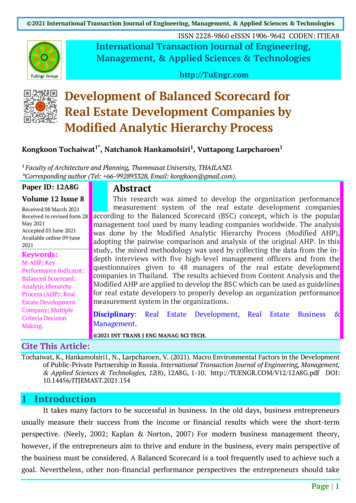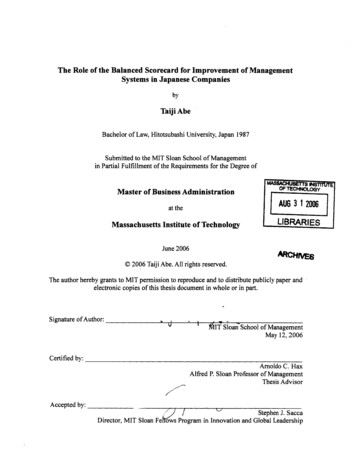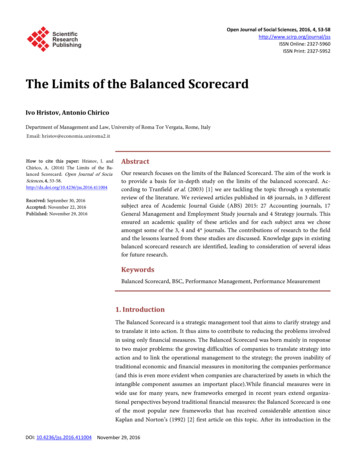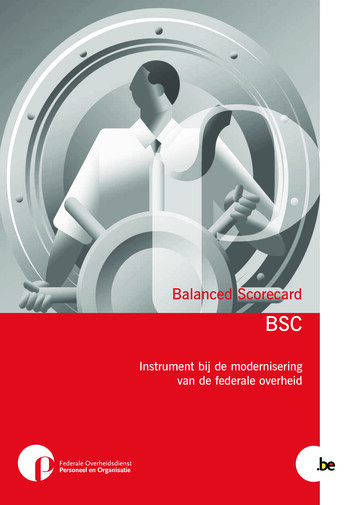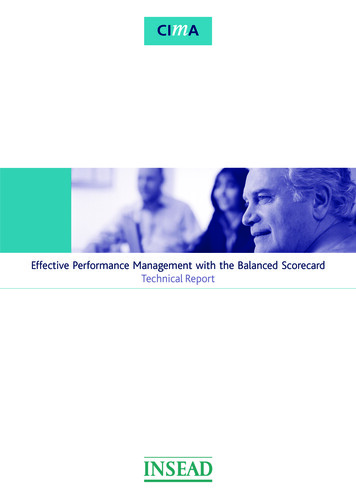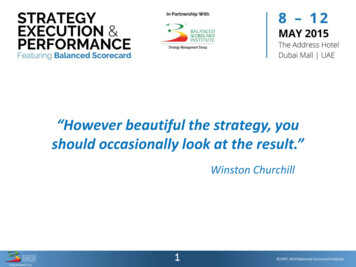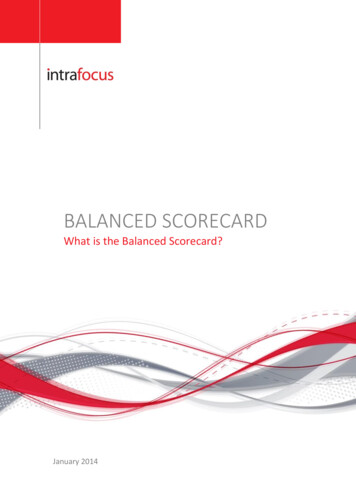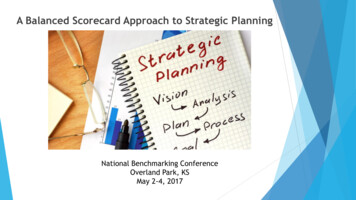
Transcription
A Balanced Scorecard Approach to Strategic PlanningNational Benchmarking ConferenceOverland Park, KSMay 2-4, 2017
Dr. Kristy BishopVice President of Academic Affairsbishopkr@Westmoreland.eduLindsay SwissDean of Planning, Assessment and InstitutionalEffectivenessswissl@Westmoreland.edu
Westmoreland CollegeLocation:Youngwood, PA Main Campus 7 centers including AdvancedTechnology Center Strong online programs Workforce DevelopmentEnrollment:Approximately 5,554full- and part-time studentsPrograms:64 associate degree15 diploma58 certificate programs
History of Strategic Planning atWestmorelandLong & ComplicatedNo OwnershipToo many initiativesNew PresidentFocus on Two ItemsEnrollmentResourcesShared ProcessClear LeadershipFocused, Big PictureClear Measurablegoals
Agenda What is a balanced scorecard (BSC)? What is strategy and how are effective strategicpriorities developed? What are objectives, measures, targets, andinitiatives? What is a strategy map? Establishing KPIs How to develop a dashboard and tracking system.
A Balanced Scorecard is:1.A framework2.A strategic management system3.A measurement system4.A communication tool
Why this framework?
Four Perspectives of the StrategyFinancialEmployeeLearning andGrowth
SomeSuccessStories
The Essential FoundationMissionWhy we existCoreValuesOur guidingprinciplesVisionWord picture of ourfuture
Mission Statement Simple,clear, and short Inspirational Long-term Easyand inspires changein natureto understand and communicate
Vision Statement . . . Isconcise Balances external and internal elements Appeals to all stakeholders Is consistent withmission and values Is inspirational Paints a word picture of the future
Values
One Definition of:Strategy represents theadopted by an organizationin recognition of its operatingenvironment and.
The importance of strategy
How Strategy is Translated into Action Developmentof objectives on astrategy map Developmentof measures and targetson a balanced scorecard Developmentof specific initiatives toaccomplish the above
Strategy Development at Westmoreland
SWOT Analysis – What is it?
SWOT ProcessTarget Groups Identified Board of TrusteesCollege staff, faculty, studentsCommunity, advisory committeesEducational Foundation BoardWorkforce ForumSessions Conducted 5 sessions, 163 participants 1,653 line items
Typical SWOT Results (Partial)BT/Board of Trustees;CT/Core Team;COMMUNITYOpportunity0125-BT-O: Keep key leaders involved with community organizations (relationships matter)0218-BT-O: Implement new software for data collection and analysis so we can have a massive impact on our community0388-CT-O: 97% of Westmoreland students remain in our region0566-CT-O: If we could capitalize on "buy-in" by everyone in the community we would not have to spend as much/many of ourresources on recruiting. People in the community would want to send their kids/selves to Westmoreland for classes.0707-CT-O: Raise awareness in the business community of the ATC0971-CY-O: WCCC has the opportunity for promotion of the college by engaging in efforts to push in to elementary, middle, and HSand support community initiatives (ex. St. Vincent prevention projects)1149-FY-O: People/population to become a cultural hubCY/Community;Strength0379-BT-S: Ability to engage advisors from our customers to offer community needs and support (?)0422-CT-S: Key persons in the community are involved with the College0424-CT-S: Continued support from businesses and community0555-CT-S: Many staff members value the opportunity to serve their community's educational and cultural needs0684-SF-S: Positive community support0686-SF-S: Building relationships within the community0697-CT-S: Community outreach and services through the retired senior volunteer program and the senior citizen service andemployment programWF/Workforce ForumWeakness0323-BT-W: Level of involvement of institution in community by staff0431-CT-W: We need to make a greater effort to promote the College within the community0706-CT-W: Raise awareness in the business community of the College0724-SF-W: How does the community know we are changing and moving forward?1070-FY-W: I wonder if, while in the process of repairing our financial situaton, we may be forgetting our purpose as a communitycollege which is to serve the community1072-FY-W: We need to make ourselves more available to the community1074-FY-W: Business/Industry/Community -- We ignore these three areas. We need to be more involved in our community and listento the needs of business.T/ThreatFB/Foundation Weakness;O/Opportunity;
Overarching Strategic PrioritiesFor Each of the Four BSC Perspectives Becomemore student-focused Improveour systems and processes toachieve operational excellence Changeour culture by valuing allemployees and providing tools needed PlaceWestmoreland College on a firmlong-term financial footing
Overarching Objectives Collectivelydescribe what we must doand do well in order to execute ourstrategy Providemore specificity than what iscontained in our strategic priorities, butless than what is contained in thecorresponding measures Shouldbegin with action verbs
SWOT Thematic Categories
Red: Strategic PrioritiesA1, A2, etc: FocusAreasBlue: OverarchingobjectivesBullets: SWOT items
Working Sessions 40 college employees invited to participate Front line staff to administrators All college areas represented Goal:use SWOT to determine initiatives,targets, and measures for each objective
Initiatives Tacticalin nature Specificprograms, activities, projects, oractions Directlinkages to objectives, measures,and targets ProperMission/Vision/Valuesflow & context:StrategicPrioritiesObjectivesMeasures andTargetsInitiatives
Performance Targets Representthe desired results of the measures Providepoints of reference to guide all ouractions, decisions, and resource allocations Communicate Typesprogress toward stated objectivesof performance targetsLong-term: Big Hairy Audacious Goals (BHAG)Midrange:Stretch GoalsShort-term: Incremental Targets
Selecting Performance Measures Linkedto strategy Easily understood chain of cause and effect Frequently updated and accessible Quantitative (use averages with caution) Avoid “date-related” measures Avoid dysfunctional measures that drive thewrong behavior
PerformanceMeasuresRetentionGraduationA,B,Crate
StrategyMap
Establishing KPIs
Benchmarks and Targets Establish Use Usepeer comparison groupinstitutional historical data as a guidepublic reporting tools to developbenchmarks and targets; may include Economic modeling data Forecasting
Dashboard and tracking system
References Robert S. Kaplan and David P. Norton, The Balanced Scorecard(Boston, Harvard Business School Press, 1996) Robert S. Kaplan and David P. Norton, Strategy Maps (Boston,Harvard Business School Press, 2004) Robert S. Kaplan and David P. Norton, Alignment (Boston, HarvardBusiness School Press, 2006) Paul R. Niven, Balanced Scorecard Step-by-Step for Governmentand Nonprofit Agencies, 2nd ed. (Hoboken, John Wiley & Sons, 2008) Frank L. Stasa (Past experience as a consultant working with for-profit andnonprofit organizations)
Questions?
References Robert S. Kaplan and David P. Norton, The Balanced Scorecard (Boston, Harvard Business School Press, 1996) Robert S. Kaplan and David P. Norton, Strategy Maps (Boston, Harvard Business School Press, 2004) Robert S. Kaplan and David P. Norton, Alignment (Boston, Harvard Business School Press, 2006) Paul R. Niven, Balanced Scorecard Step-by-Step for Government
